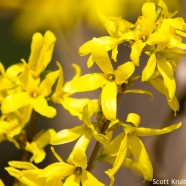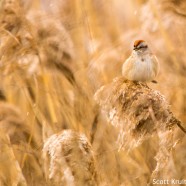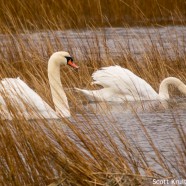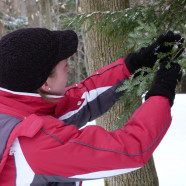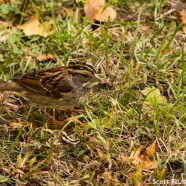Forsythia in April
It may not be native, but this Forsythia certainly has a handsome shade of yellow, growing in size and almost luminescence every day in late April. At least many of our birds and some of our other wildlife use it often for cover and perching, but it really has no major use or importance otherwise in our area. Have you observed it being utilized by our native fauna? I honestly have no idea how to feel about plant species like this now. It is not going anywhere soon, but it is not causing nightmarish problems for our environment. If people like to feel spring and appreciate nature via its...
Read MoreAmerican Tree Sparrow (Spizella arborea)
Here is an American Tree Sparrow (Spizella arborea) that I photographed during my hometown Christmas Bird Count in Stratford, Connecticut yesterday, part of a flock of perhaps 15 individuals that were staying mostly out of sight. I made sure to take the photo because it was feeding on Common Reed (Phragmites australis), one of the most notorious non-native invasive plants in North America. American Tree Sparrows are well-known as seed eaters and can often be found at the top of weeds and grasses, but I do not personally remember seeing them feeding on the “phrag” before. I wonder...
Read MoreMute Swans (Cygnus olor)
If you live in the Chautauqua-Allegheny region of Western New York you are far more accustomed to spotting Tundra Swans rather than these Mute Swans (Cygnus olor), a beautiful species that likely takes the title for most attractive non-native invasive bird in North America. Mute Swans call Eurasia their homeland but were brought to North America by humans and have taken up residence in a number of areas since the late 19th century, especially those in the east and near suburban areas and cities. They are a threat to native waterfowl because of how aggressive they are, a behavior I can attest...
Read More‘Help Me!’ Local Trees Are Calling for Help
Area conservation organizations and citizens join hands to prevent spread of devastating forest pests Collaborative Forest Pest Project – Information Session December 4th from 6:00-7:30pm at the Roger Tory Peterson Institute of Natural History, 311 Curtis Street, Jamestown Quietly infiltrating the great expanse of forests throughout New York State, invasive pest species are wreaking havoc on countless ecologically and economically valuable trees. As potentially devastating pests such as Hemlock Woolly Adelgid (HWA), an aphid-like insect targeting Eastern Hemlock trees, and Emerald Ash...
Read MoreWhite-throated Sparrows massing and feeding
White-throated Sparrows have arrived in tremendous numbers across the region, ready to eat you out of house and home all winter long! Before then, while the grass and earth is still exposed, without being snow-covered or frozen, they can feast on more natural meals. I took a bunch of photos of a few individuals in a group feeding on the lawn last week. There would not be much to chow down on if this were uniformly treated bright, green grass, one species that was chemically induced to look like the perfect lawn. These monocultures are taking up valuable habitat real estate and often consist...
Read More



